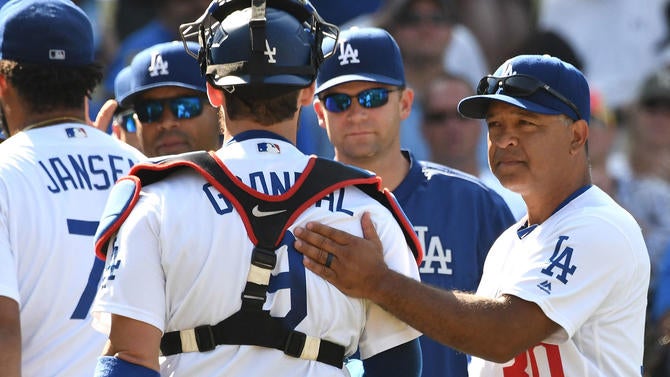Tuesday night, Indians manager Terry Francona and Dodgers manager Dave Roberts were named the winners of the 2016 Manager of the Year awards. Francona won the award for the second time. Roberts won it in his first year on the job.
Manager of the Year is, by far, the most ambiguous of the BBWAA's four major awards. The MVP ballot, for example, comes with voting guidelines. From the BBWAA's site:
Dear Voter:
There is no clear-cut definition of what Most Valuable means. It is up to the individual voter to decide who was the Most Valuable Player in each league to his team. The MVP need not come from a division winner or other playoff qualifier.
The rules of the voting remain the same as they were written on the first ballot in 1931:
1. Actual value of a player to his team, that is, strength of offense and defense.
2. Number of games played.
3. General character, disposition, loyalty and effort.
4. Former winners are eligible.
5. Members of the committee may vote for more than one member of a team.
You are also urged to give serious consideration to all your selections, from 1 to 10. A 10th-place vote can influence the outcome of an election. You must fill in all 10 places on your ballot. Only regular-season performances are to be taken into consideration.
Keep in mind that all players are eligible for MVP, including pitchers and designated hitters.
You'll notice the MVP ballot says nothing about the winner having to come from a postseason-bound team, but I digress.
The Manager of the Year ballot comes with no such guidelines. The voters are told to submit their ballot before the first postseason game, and not to reveal their ballot until after the winners are announced. That's it. That's the only instruction they receive.
Because of that, the Manager of the Year voters are free to vote based on their own criteria. Manager of the team with the best record in the league? That's fine. Manager of the team that most exceeded expectations? That's fine too. Manager whose team snuck into the postseason as the second wild-card team? Fair game.
The vagueness of the Manager of the Year ballot -- which I assume is intentional -- has devalued the award to some degree. Five of the 15 managers in each league received a vote this year. One third of the league received a vote. Last year 13 of the 30 managers received votes. Nearly half the league!
Changing the voting system could help restore some luster to the award. If everyone is following the same voting standards, it brings more legitimacy to the vote. When everyone is using their own personnel criteria and evaluating managers differently, it creates some chaos. The voting means a little more when everyone is moving in the same direction.
Now comes the hard part: establishing a voting criteria for the award. What we see on the field -- the pitching changes and lineup decisions and things like that -- is only a small piece of what the manager actually does. Much of his work -- the most important part, I'd say -- happens behind closed doors in the clubhouse.
Managing 25 alpha males -- way more than 25, really, since there are callups and staff and others around the team -- for eight months a year is a real challenge. Keeping players motivated and productive can be very difficult. Reporters have clubhouse access before and after games, but they still rarely see this part of the manager's job. It happens on the team plane, at the hotel, on the phone. Away from the limelight.
So, with that in mind, here is my attempt at a new voting system. Rather than limiting it to BBWAA members, I incorporated two outside components.
Statistical component: 25 percent
The Gold Gloves introduced a statistical component a few years ago that counts for 25 percent of the vote. We can apply the same principle to the Manager of the Year voting. How do we evaluate a manager statistically? That's the hard part.
The most common approach seems to be comparing the team's actual record to their expected record based on run differential, but that's too simplistic. Eno Sarris of FanGraphs, who himself had a vote this year, came up with some possible ways to evaluate a manager statistically. His model is based on four criteria. From Sarris' post:
- When he uses his best relievers.
- How rigid his approach to the bullpen is.
- Where he puts his best hitters in the lineup.
- How often he bunts with non-pitchers.
I don't love that fourth one because players often choose to lay down a bunt on their own. The manager doesn't have complete control of that. The other three criteria are controlled directly by the manager though. He sets the lineup and he uses the bullpen.
A statistical component built around lineup construction and bullpen usage is a good start for a revamped Manager of the Year voting system.
Players' and coaches' component: 25 percent

Who knows the manager better than his players and coaches? They're a resource, so let's use them.
Players and coaches can be polled about their manager -- anonymously, of course -- and it can be a very simple and straightforward process. It can be a short "Strongly Disagree, Somewhat Disagree, Neither Agree nor Disagree, Somewhat Agree, Strongly Disagree" questionnaire:
- My manager handles clubhouse matters well.
- My manager makes good on-field decisions.
- My manager is well-prepared.
- My manager is a good communicator.
Boom. Four multiple choice questions and that's it. Poll players and coaches in September -- perhaps it would be best to limit this to players and coaches who have been with the team the entire season -- compile the results and plug it into the Manager of the Year formula.
Is there a conflict of interest here? Yeah, there is. But is it really any different than letting BBWAA voters vote for the manager of the team they cover? We all have our biases. Media-friendly managers (and players) tend to receive more positive coverage. It's been happening for decades.
Getting players and coaches involved allows us to peek behind the curtain a bit, and get a sense of how the manager is perceived behind clubhouse doors. That sure seems like valuable information, doesn't it?
BBWAA component: 50 percent
Ultimately, the Manager of the Year is the BBWAA's award, and I don't want to take power away from the writers. That's why the BBWAA components counts for half the voting. We just have to give them some direction. Here are two guidelines I propose:
- Team payroll should not be taken into account. Baseball is more competitive than ever before. Teams of all payroll sizes are contention. The last three AL pennant winners are the Indians and Royals, after all.
- Postseason position should not be taken into account. It shouldn't matter whether the team qualified for the postseason. Teams can miss the playoffs with great managers if they lack talent. He's a manager, not a miracle worker.
In recent years the Manager of the Year award has morphed into the "manager of the team that most outperformed expectations and went to the postseason" award. That's skewed the voting towards managers of small or mid-market teams. There are always some exceptions, like Roberts this year, but most recent winners fall into that category.
Voters are going to vote how they want to vote. That's just the way it is. By explicitly telling voters their opinions should not be skewed by payroll or the team's place in the standings, it at least plants the seed that other managers might be worthy. I feel we're took quick to look at managers of contending teams, and the smaller the payroll, the better.
I think it's fair to say that, among fans, the Manager of the Year award is the least popular among the BBWAA's four major awards. We can all agree on that, right? By revamping the voting process, we can perhaps bring more meaning to the award. Right now, the voters all have their own set of criteria, and as long as that is the case, it's difficult to view the Manager of the Year winner as truly the best manager in the league for that season.






















